#Finnic people
Explore tagged Tumblr posts
Photo




Олык марий пылвомыш вате-влак [Celestial Wives of the Meadow Mari] (Aleksei Fedorchenko, 2012)
#2010s movies#femininity#drama film#sensuality#eroticism#Олык марий пылвомыш вате-влак#women#feelings#desire#Небесные жёны луговых мари#romance#folklore#paganism#Celestial Wives of the Meadow Mari#Mari people#Finnic people#Aleksei Fedorchenko#Russian cinema#sexuality#imagination#cinema of Russia#Europe#beauty#Finns#empathy#love#European cinema#tenderness#short stories#costumes
12 notes
·
View notes
Text
Everyone’s yapping about wanting a book on Haymitch’s game or Finnicks game but you know what I want? I want the first ever quarter Quell, the 25th Hunger games. To those who don’t remember the whole premise of the first quarter quell was everyone had to VOTE who got taken into the games! Which is already a horrific concept. This could either take place with the victor themself as the perspective ( a way to explore other districts, preferably one of the career districts, especially 2), OR a personal idea of a perspective from Tigris in her designer days! So not only do we have more insight into the games, and capitol, but the deterioration of Snow and Tigris’s relationship.
#the hunger games#quarter quell#tigris snow#look Haymitch and Finnic are cool and all but their stories are known#I don’t think Suzanne will have anything else to say about them#I just want to see Tigris as a designer and perhaps more insight into other districts and the evolution of the hunger games#I’ve also heard people talk about an Avox story or a first rebellion story which would also be a pretty cool idea#thg#tbosbas
38 notes
·
View notes
Text
huh. hey cool- I learned a new Human Geography thing!

ESTONIA HAS LEGALISED MARRIAGE EQUALITY ❤️🧡💛💚🩵💙💜
#the more you know#human geography#indigenous people#finnic language group#sociology#anthropology#physical geography#national identity#Estonia#Baltic#Nordic
23K notes
·
View notes
Text
I have no sources and zero recollection of where I read this, but there is a speculation that the first written mention of finnish (or finnic) peoples' existence, and that of the traditional dog breed finnish spitz, kind of loop around to support each other. It was from some Ancient Roman history, one of those "I heard this from a drunk sailor who heard it from another drunk sailor and who am I to dispute such a reliable source" historians writing down everything that is known about the known world.
It was just one random offhand side-clause mentioning that when you go far out enough into the north, there are wild people living in there, who have red dogs. And the circular logic here is that finns live in the north, the finnish spitz is a red dog, and since it must have been finns, the dogs must have been early finnish spitz. And since finnish spitz is the dog of the finns, therefore the northmen with the red dogs must have been finnish.

#I am posting this roughly 80% in the hopes that someone who knows better can cite the source I vaguely recollect#to either prove me wrong or prove me right#as for myself#I'm just saying words recreationally
422 notes
·
View notes
Text


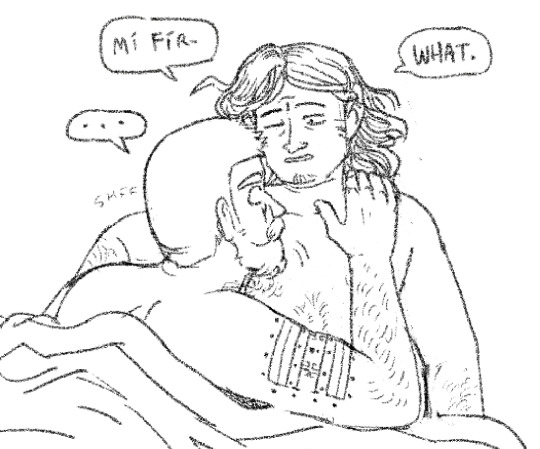



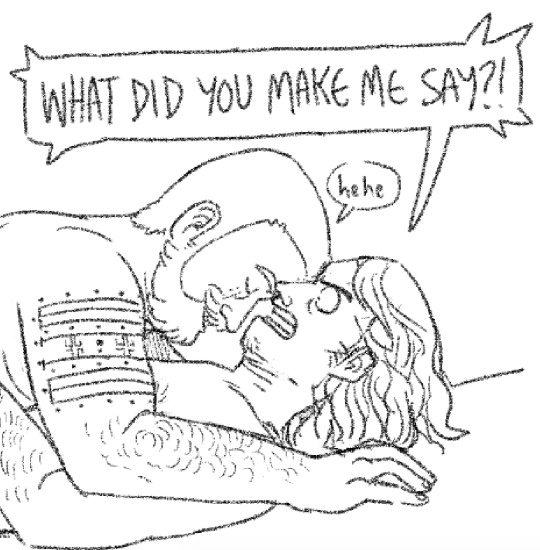
Come On Man.
(Extensive linguistic notes for this 'balls in my mouth' comic under the cut)
The extensive linguistic notes for this "balls in my mouth" comic:
Brakul's first language is the West Rivers dialect of the broader Highlands language, which is part of the Finnic language family. It first split from the Proto-Finnic spoken north of the Viper about a millennia ago with migrants traveling south overseas, and further split into what are now the two native Finnic language groups in Wardin (the Highlands and North Wardi tongues). The Highlands language is a dialect continuum- most neighboring dialects are mutually intelligible, but people from opposite ends of the language's home region would have troubles communicating clearly (though the continuum is not wide enough for any to be fully incomprehensible).
Brakul knew some very, very basic Wardi from occasional contact with Ephenni traders as a teenager, and would later become fluent in the South Wardi dialect as a second language. Wardi is from a wholly separate language family than the Finnic languages with EXTREMELY distant common ancestry, and very different in form and function. Wardi is in many ways less specified and direct, having a smaller variety of individual words to communicate emotional/sensory states and instead imparting many layers of meaning to the same words in different contexts, which Brakul sometimes finds difficult and irritating to navigate. This is one of a number of reasons he often expresses himself more fully in his mother tongue.
Janeys is a native Wardi speaker (South Wardi dialect), fluent in 'Seaway Burri' (which is a lingua franca of the Mouth sea powers, many people along the coastal cities know it as a second language), and semi-fluent in 'High Burri' (state language of the Burri Republic), and in the present day has a modest comprehension of the West Rivers Highlands dialect. This takes place 4.5 years after he and Brakul met, and he mostly just knows basic utilitarian conversational terms and parts of speech, and has a decent understanding of the grammar and how to conjugate verbs. After 13 years of exposure to Brakul talking at him and occasionally deigning to explain what he's saying, Janeys can Sort Of hold a conversation.
---
NOTES ON THE POST ITSELF:
I = Sí
My= Sig
You= Mí (casual) Mís (formal)
---
Mí vírim is “I love you”.
The unconjugated form of the verb is vírir. The dead literal translation is “to need”, but "mí vírim" translates more accurately as "I love you" than "I need you". It DOES have connotations of need, it expresses love as a sense of wholeness and natural dependency- you say it to express affection towards someone to whom you owe your existence, to a line of ancestors, to your descendants, to the people you create or provide for your descendants with. It says "you are part of my sense of place in this world, you connect me to something greater than myself that sustains me". It will mostly be spoken between immediate kin (parents, children, siblings), husbands and wives, and in practice of venerating your ancestors. This is a gay as fuck thing to say to an unrelated man.
There's at least three other ways to directly say "I love ___" one of which is an affectionate expression of camaraderie, one of which communicates strong aesthetic appreciation, and one that is used in practice specifically to express affection/gratitude towards livestock (though can be used more broadly).
Janeys comprehends the phrase "Mí vírim" as “(I) [UNKNOWN VERB] you” and he's able to discern from Subtle Context Clues that it's something like 'I love you'.
He guesses the unconjugated verb inaccurately as (v)írer, as -Er and -Ur verb endings are more common than -Ir endings, and -Er/-Ir verbs share all the same conjugated forms.
Wardi languages have no ‘v’ sound to begin with, and the ‘v’ here is very soft, between a ‘vuh’ and ‘fuh’. This doesn’t come naturally to Janeys (or most Wardi speakers in general) and comes out as a 'wuh' on first impulse and a hard ‘fuh’ when he tries to replicate it.
This is something he never gets good at and Brakul is grateful that it’s his brother who was named ‘Vrailedh’ (Vrai-lehd-hh)) and not him so he doesn’t have to hear ‘Wrai-lehd’ or ‘Frai-lehd’ all the damn time by his Wardi compatriots. (Many of them don't even get his actual name right, but it's a lesser sin of not rolling the R and under-emphasizing the -ul)
---
"Sí brūlmim fágh filshíbe" is “I am very gullible”. The use here is not particularly cruel and is more just that his first impulse upon realizing Janeys will repeat anything he says right now is to make a "someone wrote gullible on the ceiling" level joke at his expense.
Fágh is a word used to emphasize an adjective and some nouns, functionally close to 'very' but used specifically for non-physical/non-sensory qualities (emotion, personality, etc). You could use fágh in the sentence “I’m so sorry” "he's such an asshole".
Brūlmim is "I am" in present tense. The unconjugated form is brūlmur, meaning 'to be' in a permanent sense, as a matter of nature. Other verbs are used for ‘to be’ in a purely transitory sense (“I am tired”) or describing a prolonged but impermanent state, usually past tense (“I was a stupid teenager”).
Filshíbe straightforwardly means 'gullible'.
The 'h' at the end of fágh is vocalized as an exhale, sounds a little like 'fog-uh' with a VERY soft and breathy 'uh'. The '-e' at the end filshíbe is also exhaled, coming out as a quick, soft 'eh'. Neither of these sounds are natural to a Wardi speaker (especially the breathy 'eh', most -e ending words are pronounced with a strong '-ey').
Janeys is comprehending “I’m (very/so) [UNKNOWN WORD]” here, and his face is being touched so softly so [UNKNOWN WORD] is very compelling and he's learning new things and is kind of in the zone so might as well say it back.
---
"Mísig uns drótes vísti sig bahrég, s'vaige do mi?" means "Your balls in my mouth, please?". What makes the sentence Particularly funny to Brakul here is that it's Excessively polite (using a formal and deferential 'your' and very gracious 'please') and jarringly accompanied with lowbrow slang for testicles. A more tonally accurate english translation would be "Sir, may I please perchance take your fat fucking sack in my mouth?"
Mísig means 'your', but specifically implies deference- it's a word you would use to address an elder or authority figure, or to use while being very, very polite. (Mís is the equivalent deferential 'you').
Uns drótes is one of several slang terms for testicles. This one uses the word 'boulders', and is thus Specifically implying 'big balls'. It's lowbrow and a very mild expletive (in the same degree 'ass' is in English).
Vísti means 'in' or 'inside', as a physical state of something being inside of another thing- you would use it for 'there's a bird in that cage' but not 'there's fear in my heart'.
Bahrég means 'mouth', which is almost always used in the purely anatomical sense. The other word for 'mouth' in the language more commonly refers to the mouths of animals (might be better translated as 'maw') and also gets applied to non-anatomical objects (ie 'the mouth of the cave').
S'vaige do mi means 'thank you' (dead literally 'my gratitude to you', the S in S'vaige is a contracted sig/'my') but is translated here as 'please' for clarity. There isn't actually a word that directly correlates to 'please' in the Highlands language, a polite request is accompanied with a 'thank you' instead (IE: "Could you pass the salt, thank you?"). This is one of two direct ways to say 'thank you' and this is the more intensely polite of the two.
Janeys will have understood this sentence as "(polite 'Your') [UNKNOWN WORD] (in? inside? within?) my [UNKNOWN WORD], please." This one throws him off, but he's pretty sure he's about to be kissed on the mouth for the first time in his life so he's willing to go with it.
#This information is buried in the Linguistic Notes Section but this takes place about 4 and a half years after they met#At which point no ones balls have been in anyone's mouth yet#brakul red dog#janeys haidamane
415 notes
·
View notes
Note
estonian just feels like finnish with a lisp sometimes ill be honest
"Mitä vittua sä teet" -> "Mida vittu sa teed"
(sorry for the 7 estonian people on earth that i may have upset)
Yeah honestly it just feels like Finnish without some letters. Estonians can't even use the argument that Finnish is Estonian with extra letters because Finnish (usually) preserves words very closely to what the proto-Finnic form was.
Let's take proto-Finnish reconstruction *avanto: Finnish, Ingrian, North Karelian, Votic: avanto Estonian dialectal: avand
Or what about *halko: Finnish, Ingrian, Karelian: halko Estonian, Ludian, Võro: halg
Or *kaikki: Finnish, North & South Karelian: kaikki Estonian: kõik
Estonian had so many letters changed and dropped and even made up some new letter out of thin air...
#satire#i love you estonians#finnish#estonian#suomitumblr#do estonians use tumblr#what is your estonia tag like we have#suomipaskaa#suomijutut#etc.
100 notes
·
View notes
Text
Also, can we stress enough that most Ugro-Finnic peoples actually inhabit the territory of modern Russian Federation and that most of their languages are either on the verge of being extinct or already are?
I know that some folks (unfortunately, often they are Ukrainian) like bringing up the fact that white Russians, despite claiming to be the “most Slavic country of them all” (like, lmao, how stupid that even sounds), are actually often ethnically Ugro-Finnic. And I am deeply against this approach.
The fact that many white Russians today are not even that Slavic is actually a sad testimony to systemic Russification: cultural and linguistic erasure, often done with tools such as religion (the Orthodox Church does not really care about preserving local languages and customs, am I right?), schooling system (if I am correct, teaching of Indigenous languages in Russian schools is a joke, it’s often just an hour a week that nobody cares much about really; also it cements the “state identity” in students as the primary one) and even so innocently looking ones, such as intermarriage (because it is obvious that most children from such marriages would choose the national identity of the parent that belongs to the dominant ethnic group).
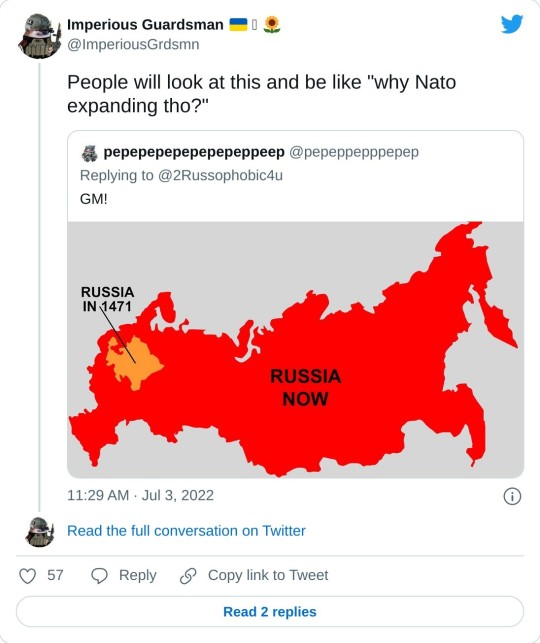
#russian colonialism#russian imperialism#ugro-finnic peoples#ugro-finnic languages#karelia#komi#udmurtia#selkups#nganasan people#mari#enets people#nenets people#and others
962 notes
·
View notes
Text
right here waiting | f.o

finnic odair x fem!reader
summary: after the quarter quell you vanish, no sign, no trace. you left behind your boyfriend, finnick, who could just not wrap his head around your disappearance. what happened?
warnings: typical hunger games violence, blood, torture, strong language, descriptions of wounds.
a/n: this fic is a long time coming. i love finnick and is one of my favorite characters but i can never find the right storyline for his character. it’s also been a hot minute since i’ve watched the movies so if there are any inaccuracies just look away lmao. hopefully, i can continue to write for him. i hope you guys enjoy this one !! feedback is appreciated ! also since i haven’t written in a very long time this came out shorter than i wanted it too. sorry about that.
requests open
not proofread
Copyright © 2023 bartxnhood. All rights reserved. This original work is not allowed to be reposted on any platform in any format.
✵ ✵ ✵ ✵ ✵ ✵ ✵ ✵ ✵ ✵ ✵ ✵ ✵ ✵ ✵ ✵ ✵ ✵ ✵ ✵ ✵ ✵
“run!!” your voice echoed, the dome was collapsing. “finnick, run!” you turned around, grabbing his wrist to pull you along. the arena was exploding as you tried your best to dodge the debris. katniss had used one of her arrows and shot the border of the arena causing it to collapse. now, all the victors began to spread out to take cover from the panels.
“holy shit, y/n, look out!!” finnick was ripped from your grasp as the ground below you rumbled and sent you falling.
"y/n!? “y/n!" you could hear someone calling your name in the distance, it was a panicked finnick searching the forest floor for your body. you opened your eyes trying to search for him but your vision was too blurry. everything was spinning. "finnick."
in seconds you were back on the ground and eyes falling back, slipping into unconsciousness.
it had been weeks since your disappearance, at first most people just assumed you had died that day in the arena. either by debris or the capital, but finnick knew that you were still out there somewhere.
for finnick, it was a nightmare. he barely left his room. every day that you stayed missing he slowly began to lose hope that he’d find you again. so, he began to mourn.
he was almost unrecognizable. finnick was letting himself go. he began to neglect his health, he refused to eat, he couldn’t sleep, and he was killing himself.
guilt heavy on his shoulders after losing you, even though the people around him had assured him that your disappearance wasn’t his fault. but finnick thought that had he held on to your hand just a little tighter you would’ve made it out.
katniss came to him one day, finding him lying on his bed staring at the ceiling like any other day. “this isn’t like you.” she stated. finnicks eyes found her, standing at the edge of his bed. the girl sighed, crossing her arms. “you’re killing yourself.” he shrugged. “what else am i supposed to do?” “fight for her?” “how?” katniss fell silent, she wasn’t sure how to proceed with the news she had just received. slowly, she moved to his side and sat down. “she’s alive.”
everything froze, he was sure he even stopped breathing. finnick sat up slowly so he could face katniss. “what?” “she’s in the capitol. with peeta.”
the bright fluorescent light of the hospital room burned your eyes, you brought your hand over your eyes to adjust to the light. once your eyes adjusted to the light you scanned your surroundings. you looked at your hand, you had an iv in, and you heard the faint beeping of the monitor next to you.
what happened? how did you get out? where were you? you barely remembered what happened in the capitol, it was all a blur. you began to panic, searching around the room wondering if you could get out.
the door opened, and you looked to your left and saw someone entering. “kat?” your voice was scratchy and hoarse. she now stood at your bedside holding your hand. she hummed, “hi, y/n/n”. “thank god” you breathed, tears welling in your eyes. “i thought id never see you again” katniss hushed your cries, wiping away the tears falling from your eyes. “shh, it’s okay. you’re okay” she smiled. caressing your cheek.
you had lost a lot of weight at this point, your face was sunken in. your body thinner than it had ever been, and you were beyond exhausted both physically and mentally. “oh, honey” she coaxed. you held onto her hand tightly, “there’s someone here who wants to see you.” she gently escaped from your grasp, walking to the exit.
"fin. you breathed, watching him enter the room. it felt like a dream you had wanted to see him for so long. it felt like an eternity. the one you loved so dearly, the one who has saved your life multiple times. "y/n" he walked over to your bedside. he was hesitant at first, but when you held your hand out for him he gained confidence.
"you're here." you weakly smiled, reaching for his hand. he found himself on the edge of your bed, holding you
“of course i am, sweets. where else would i be?" he chuckled softly, and you hummed. you brought your hand to his cheek. you examined his face and he placed his hands on yours. finnick studied you, making sure to soak in every detail.
"you'll never have to go through that again, y/n. i promise i'll do anything to keep you safe." he kissed the top of your head.
you smiled as he pulled back, and tears fell from your eyes again. "i know, fin" you said softly. "you look tired, love" he sighed. it had been such a long time since you'd been in his embrace, you missed everything about him. his jokes, snarky comments, his grin. he was your everything. "i am." you hummed, while he sat holding your hand. “rest, i’ll be right here when you wake up.”
#finnick odair fluff#finnick x you#finnick odair x reader#finnick x reader#finnick imagine#thg finnick#finnick odair#finnick x y/n#hunger games finnick#finnick odair x you#thg imagine#thg fanfic#the hunger games
3K notes
·
View notes
Note
Hey, I noticed that in one of your posts you showed an Iron Age Finnish woman's dress. Would you happen to have a good idea of what Finnish men were wearing in that era? The information on it seems sparse. I do have a relevant book that I'm about to look through, but I'd like to hear your insight too!
Hi! Thanks for the question (and sorry for the slow answer), I do love Finnish Iron Age clothing so it's always my pleasure to write about it. I've been wanting to do a deep dive into this for a long while, so maybe I'll do at some point a post about women's dress too.
Unfortunately no one has good idea of the Finnish Iron Age men's dress (and if you find any book or other source that claims otherwise, do not trust it), since there's much fewer archaeological finds of men's dress than women's dress. The most accepted theory on why the textiles of women's dress survived surprisingly well is because of the bronze ornamentation commonly sewn into especially the fine women's dresses of the era. The bronze protected them from decomposing fully. Presumably men's dresses were not decorated similarly then. There are some finds though and we can piece together at least some kind of vague picture.
I will be discussing the period from Viking Age to Crusade Age in Finland. Viking Age is often defined to cover 800s to mid-1000s and the Finnish Crusade Age started right after the Viking Age and ended in the end of 1200s, where the Finnish Medieval era begins. Crusade Age refers to the period where mostly Swedish (also German) crusaders in the span of couple of centuries conquered lands of the Baltic-Finnic pagans. The crusades of this period targeted pagans all over eastern Baltic Sea, including Baltic-Finnic Karelians, Livonians and Estonians, and Baltic peoples, and the Scandinavia too, where Sámi people were targeted. After that the Finland and Sápmi were colonized by Norse people and stayed that way untill Finland was transferred under Russian rule, but to this day Sápmi still stays under colonial rule, including Finnish colonial rule. The current Finland was very multicultural area, mostly populated by Finno-Ugric peoples, including Sámi people, Karelians and various Finnish peoples.
It's important to understand that even just Finnish peoples where not homogeneous, but had distinct, yet of course strongly related cultures. These were Finns (suomalaiset) (yes most people we now call Finns were not in fact called that) in the coast of southwestern and western Finland, Tavastians (hämäläiset) in central-western lake-Finland and Savonians (savolaiset) in central-eastern lake-Finland. This means we can't mix findings from all over Finland to reconstruct a dress without evidencing that all the elements were actually used in one place. These three tribes had broadly similar base for their clothes, but distinctive jewelry and detailing. The big divide was and has always been between eastern and western Finnish peoples. This is because western Finnish people were in close contact through the sea with Norse people and southern Baltic-Finnic peoples, while eastern Finnish people, Savonians mostly, were influenced a lot by their proximity with Karelians. Another dividing factor was the very different environmental conditions between western and eastern Finland. The Finnish coast especially in west is very flat and fertile land, while the lake area, especially in eastern Finland is very rocky, hilly and quite infertile. The main way it effected clothing differences was that western Finland being more wealthy had more elaborate clothing. Tavastians in both occasions fall quite in between, but they tended to be more in the western cultural camp.
My most important sources are a study by a doctor of cultural anthropology, Jenny Kangasvuo, Savon historia I (Savonian history) digitized and open sourced here and the digitized archeological collection of Finnish Heratage Agency. They are all in Finnish so not very useful for most people unfortunately.
Finnish Men's Dress in Viking and Crusader Ages
The basic garments men wore were broadly similar as women. They wore a shift/shirt, knee or above-knee length dress, cloak, belt, shoes and some kind of headwear. Wool was used most commonly, though the shirt would sometimes be linen too. Even evidence of silk has been found in some western Finland graves. I would assume that would be from a dress of some great man, who traveled to gain riches, possibly with vikings. Embroidery and decoration with metals was a typical feature of the whole Eastern Baltic Sea area. In Finland during this period bronze was the most common decorative metal, but silver was used too. Decorative elements were usually woven with small bronze spirals into all kinds of patterns. Here's examples from the reconstructed Ravattula's dress (Finns) used by women.
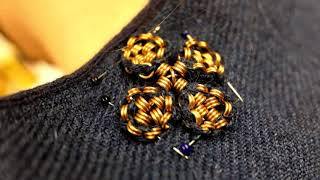

Shirt
The shirt (in Finnish shift of both women and men was called shirt) was basically a long shirt or under dress. We can assume it was similar to those of women's except shorter since the dress men wore was shorter too. They were made from wool or linen, I would assume wool was used in winter and linen in summer, when linen was even available. The neckline had a cut and closed with a bronze brooch. Horseshoe brooch was common. The first one is a quite typical bronze horseshoe brooch with a bit of ornamentation from Salo (Finns). The second one is from Tuukkala, (Savonians), it has exceptional ornate detailing and is uncommonly silver, not bronze. The third picture has two quite uniquely ornamented horseshoe brooches, first from Köyliö (Finns), second from Kurikka (Finns).
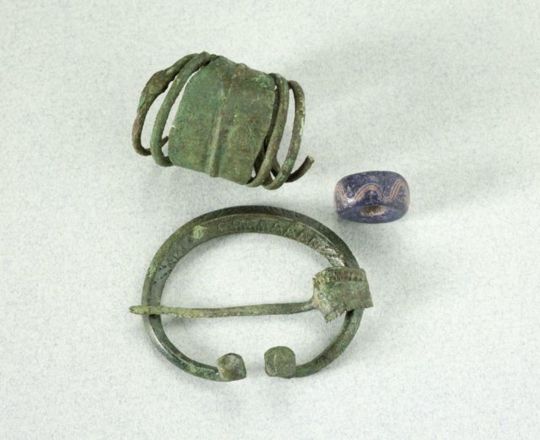
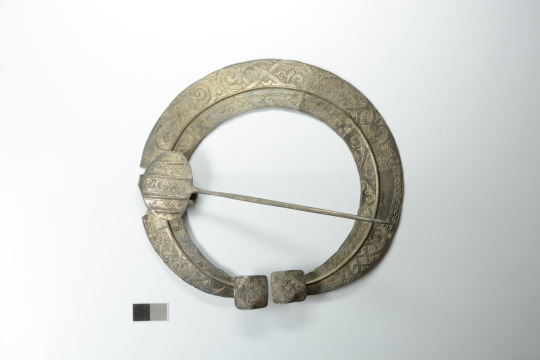
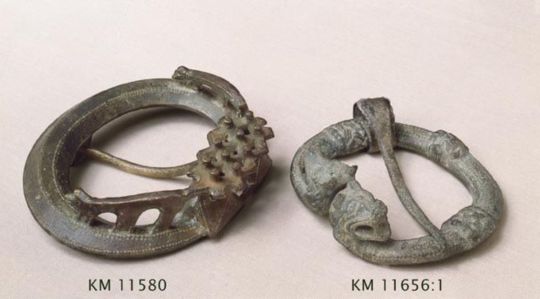
Legwear and footwear
Very little of men's legwear has survived and it's unclear weather men wore pants or separate pant legs, leg wraps or perhaps long socks. Evidence of strings decorated with bronze spirals and tablet woven band has been found in leg area of men's graves. This could mean that they wore either leg wraps, long sock or some sort of pant legs that needed to be secured with string or band under knee. Women used strings and tablet woven tape to secure leg wraps and socks, which I think supports that theory. Sometimes both bronze decorated string and tablet woven band was found in the leg area, which would still be explained by this theory, since it was common to decorate the ends of the bands with bronze decorated strings. Here's an example of sock bands just like that from the earlier mentioned reconstruction of the Ravattula's women's dress. Since men's dress was shorter, I think it would make sense if they still wore some kind of pants or separate pant legs with socks or leg wraps like that.
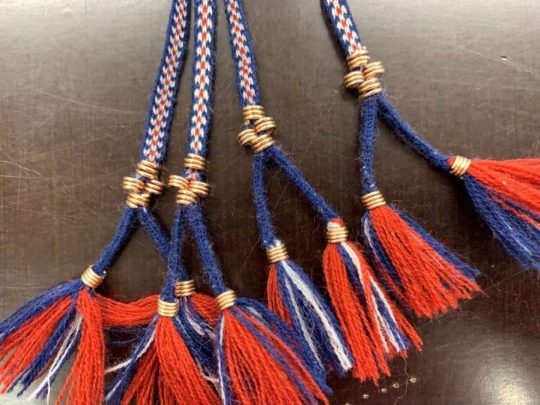
However, the strings and bands could have also been part of the shoes. Everyone probably wore similar shoes - laced leather shoes with a bit of pointed end. They might have been short or ankle length and the lacing was done with either leather cord or tablet woven band, which would also explain the findings. Socks or feet wraps would have been used in them, and straw or wool could be added as filling for warmth. Here's a pair of traditional Izhorian shoes from Estonia from early 1900s, and a pair of traditional Sámi shoes. The designs were likely roughly similar in Viking and Crusader Ages, though obviously more simple, and it's probable that Finnish shoes very something like that too. Here's a 1893 drawing of what findings of shoe material from Korpiselkä (Savonian or Karelian) might have looked like. Considering the quality of archaeology of that time, copious amounts of salt should be applied. And finally as a fourth picture there's reconstruction shoes from Ravattula's dress.


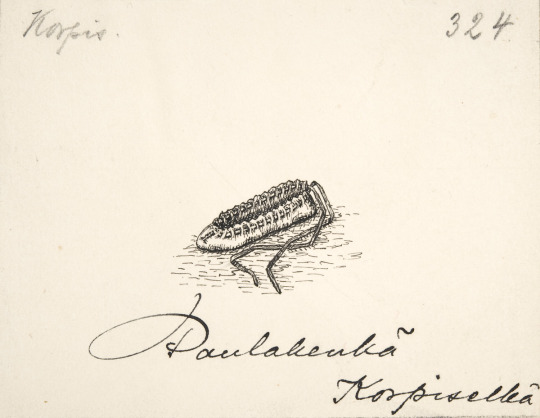
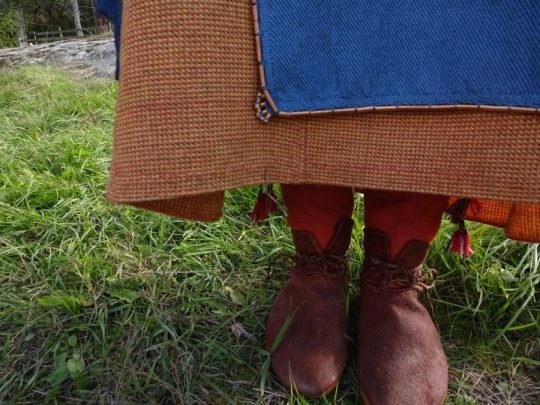
These are not necessarily mutually exclusive theories. The lacing of the shoe could have been laced up the leg and used also to secure either sock or leg wrapping, or they could have been separately secured in ankle and knee respectively.
In some graves twill fabric has been found in the leg area. It could be part of pants or for example leg wrapping, which was often made of twill. One theory about pants is that they were similar as some findings in Sweden, where fairly tight pants made of twill were secured at the hem with buttons similar to cuff studs. These kinds of cuff stud buttons are quite a common find in Finland and some have been found in men's graves close to legs.
Dress
Again there's not much findings of dresses, but a little more perhaps. It was usually from wool. The shape was either a tunic or an open coat. In Karelia there's findings of men's dress suggesting tunics thicker than women's dresses and made from sarka, a type of broadcloth. On the other hand, in Masku (Finns) they found buttons in a row on top of the torso, which suggest a coat closed with buttons. The first picture is a drawing of the grave find. Similary coak closing amounts of buttons have also been found in other places in western Finland. This suggests that Finns and probably Tavastians too wore long coats buttoned to the waist and Savonians wore tunic of Karelian influence. Below there's couple of version of what might this western Finnish men's coat dress could've looked like. The first is an imagined version of the coat based on the Masku grave finds, second is just as imagined version based on Eura (also Finns) grave finds.
Take these "reconstructions" with a strong dose of salt. These are more artistic reconstructions than scientific, since there's not enough material and too much guesswork needs to be done. And because we can see in the Masku grave drawing right here that the other deceased has a large buckle to (probably) close the shirt (to be fair, it could for a cloak too), like was typical, I find it implausible that the coat neckline would be small and round covering the buckle. If you make a decorated big buckle, I assume you want to show it. I would find a v-neckline more probable. It's also easier to make without wasting expensive fabric.

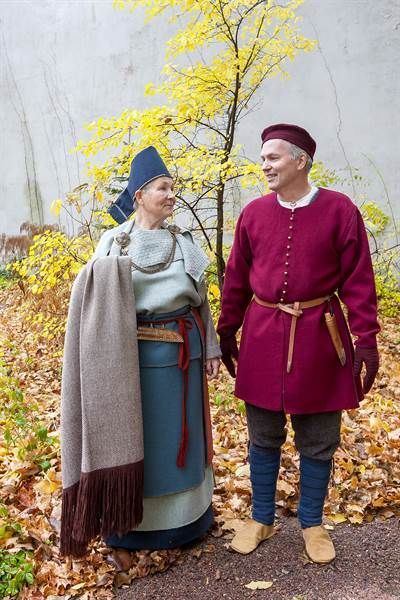

The buttons are interesting. There were what you would imagine - your typical buttons made of bronze like seen in the first artifact from Hattula (Tavastians). But then there was silver jingle bells used as buttons, found for example in both Masku and Eura graves, Eura findings pictured below.


It's possible, even probable I'd say, that the hemlines of men's dresses were finished with tablet weaving patterns, like women's dresses. Also I would assume the pattern of the men's dress (and shirt) was mostly similar to the women's underdress/shirt patterns. So here's couple of different reconstruction patterns for women's dress. Different historians have made different interpretations of the patterns, so it's very much undecided what it really was like.
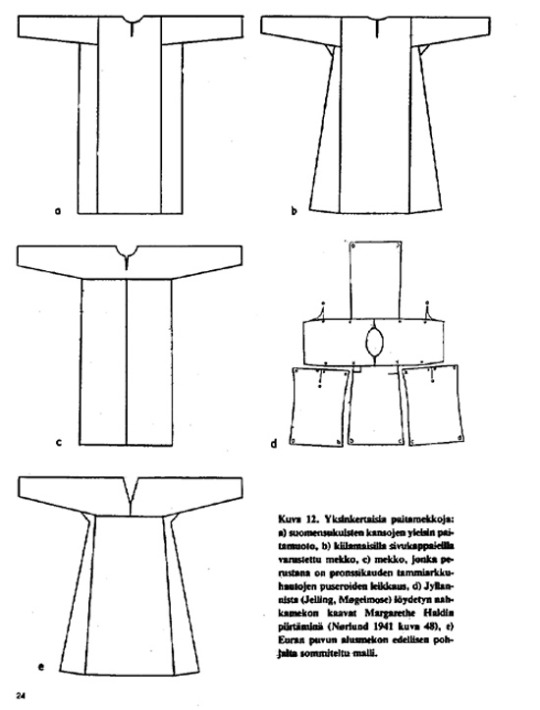
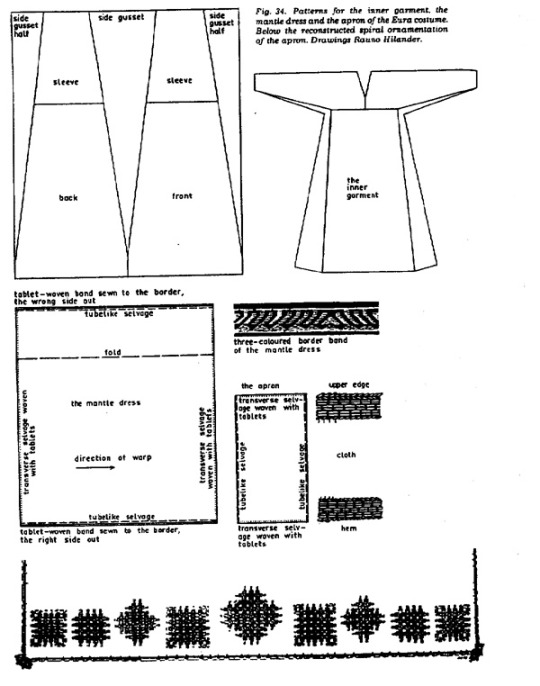
Belt
This is likely the most ornamental part of men's dress. They could be made out of leather or tablet woven band. And there's another east-west cultural divide here. Karelian belts were made out of leather, were usually 1,5-2,5 cm wide, decorated with iron or bronze studs and had a buckle made out of iron or bronze. These types of belts have been found in Savonia too, for example in Tuukkala grave find, which you can find very cool pictures of in this photo documentation of the dig in pages 173-175. In western Finland a "hela" belt was the common style. I don't think there's a world for hela in English. It's a sort of decorative lamella, small metallic plate (not necessarily square but often so) attached to fabric or leather with studs or sewing. Hela belt came from the Permians of Kama river, who were one of the many Finno-Ugric peoples who used to populate much of European side of Russia. Karelians lived closer to Permians, so you might think Permians would influence eastern Finland more, but my theory is that the costal Finns, who frequently joined viking crews and at least were in close contact with merchants including vikings, who would travel along the eastern route through the eastern European rivers, where they could go all the way to Kama river or at least meet traveling Permians. Here's yet another Finnish source more on the Finno-Ugric people around Kama river.
Anyway, hela belt was made of leather and filled with small decorated lamellas, often in square shape, but various other shapes too, like animal ornamentation. In this period hela belt helas were bronze. First image is a nice full set of hela belt metal pieces found in Pirkanmaa (Finns). Second is an older example, right before Viking Era, from Vaasa, costal settlement, (Finns), depicting a very Permian style. The third one is a lion hela found separately in Pälkäne (Tavastians). They are also found in Tuukkala, showing that both eastern and western cultural influences were present there at the same time.

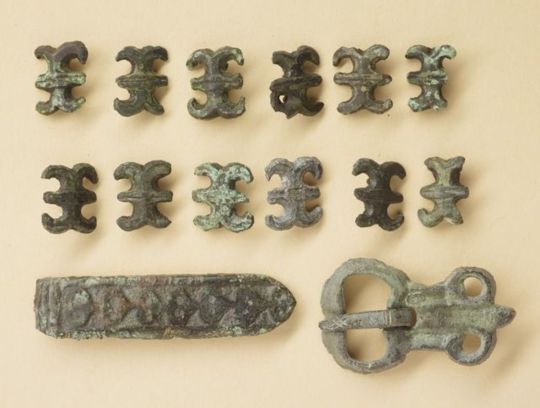
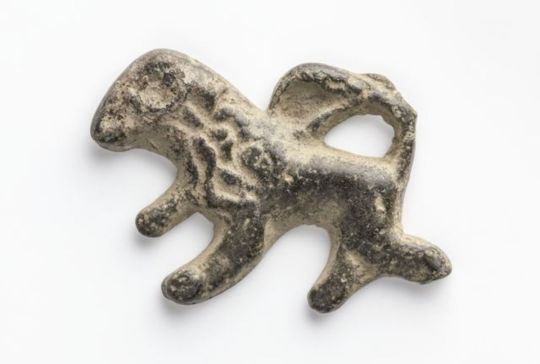
Another western Finnish belt type for men had intricate tassels decorated with bronze spirals hanging on the waist at the end of the belt. They could be made out of leather or tablet woven band. First image depicts a reconstruction of such tassel. Belts in east and west would have strap dividers to hang straps for things like purse, knife and sword. The first picture above has couple of those, but the second picture below has two more of them in more detail in the middle of the picture. These finds are from Lieto (Finns).


Cloak
Like women's cloak, men's cloak was woolen and either a square or trapezoid. Cloak is yet another east-west divide. In western Finland men's cloaks have embroidery with bronze spirals. They in fact appeared earlier in men's cloaks (in 900s) than in women's cloaks (1100s). They were also a little different in men's cloaks. The spirals and the patterns themselves were bigger and the fastening thread itself was also used for the pattern creation, unlike in women's dresses, where the thread was mostly covered. In eastern Finland there has been no finds of bronze decorations in men's cloaks, mostly only cloak brooches have been left of them. Unsurprisinly same applies to Karelia. This also means there's very little fabric left too. There's one exception. In Tuukkala (Savonians) they found a piece of fabric probably from men's cloak, though it could be from a men's dress too. It was striped, with possibly white or brown base and wide stripes of red, blue and yellow. So perhaps eastern Finnish cloak was not non-decorated, but the decoration was in the fabric pattern. Unfortunately it's hard to know how common fabric like that was, when so little of it is left.
Accessories
It's safe to assume men too wore some type of headwear, but none of those has survived. It probably means it was entirely made out of fabric whatever it was. Some type of hat or cap was certainly used in cold weather at the very least. Tablet woven headband was also possible option for not too cold weather.
In Tuukkala there was couple of interesting jewelry finds too. Two graves had a necklace type mostly found in Karelia. It was birchbark tape covered with nettle fabric and had square helas sewn into it. There were also more typical Finnish necklaces made of beads and bronze spirals.
Razors have also been found with men in their burials, so we can assume shaven faces or at least trimmed beards and moustaces were fashionable.
#dress history#historical fashion#historical clothing#fashion history#history#iron age dress#finnish iron age dress#finnish history#archaeology#answers#anon
227 notes
·
View notes
Text
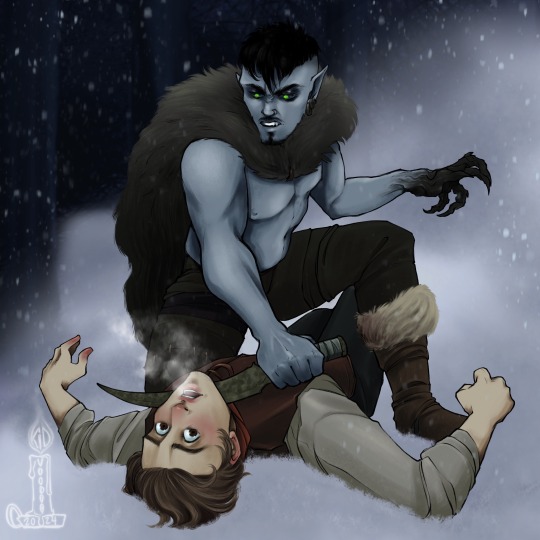
He never should have gotten lost
Truthfully, it was not Bojan’s fault. The caravan was hurried across the icy roads in fear of the approaching blizzard, the mounted guards pushing the desperate people and stock animals alike. It wouldn’t matter, they were doomed across the Käsivarsi, it was always too treacherous for a band of inexperienced Traders. The panic and hurried chaos found some of the wagons sliding and the animals pulling them spooked and scattered. The guards shouted for the rest to grab the horses lest they be lost in the wilderness.
And so he found himself here, lost in the frigid woods following hoof prints that disappeared under the freshly falling snow.
Bojan shivered as he moved silently as possible through the trees, afraid to whistle for the missing animals lest he attract unwanted attention…
“Susia,” the gruff voice of a bearded hunter warned, they had stopped briefly in a village overlooking the Kilpisjärvi. “Wolf packs. They travel together, hunting animals like your horses. Will kill you in your sleep, they stay away from fires. Sleep in shifts.” The guards took any advice from the locals, trusting their knowledge of the wilds.
“And boy,” the hunter addressed Bojan who startled at the sudden attention. “You watch for Väki. He hunts for people like you. Foolish people.”
The guards all snickered at that, Bojan huffed and pulled his coat tighter, stomping out of the hunter’s shack.
Foolish indeed, he scowled as his fingers and toes froze. He could find the road again, to hell with the horses-
BAM
Something slams into his back, throwing him face first into the snow. For a brief and panicked moment he thought one of the horses had charged him, the force was so strong it knocked the wind from his lungs, but as he scrambled to crawl away, he heard a deep growl.
Wolves
In his panicked state he let out a yell and felt a powerful grip grab at his shirt collar, wrenching him onto his back.
Oh God it’s gonna tear my throat out-
The cold press of metal against his windpipe startles his screwed shut eyes open.
Green.
Bright, glowing, inhuman green irises bore into his hysterical brown ones. A deep snarl, like a wolf erupts from human lips. Human?
No, not this creature.
His skin is a pale greyish-blue and his ears are pointed and curved, he’s shirtless save for a thick cloak of pelt’s around his neck and shoulders, strong and powerful looking arms level a curved and pockmarked knife to Bojan’s throat. The creature’s other arm is raised, his hand not flesh and blood but a twisted claw of tree roots and bark, fingertips hooked and wickedly sharp. His expression is pulled into a fierce glare, dark brows furrowed over even darker eyes that hold two glowing orbs at their center, a hypnotic and terrifying stare meant to shatter the bravery of any foolish man who strays from the path…
Just like Bojan did.
“P-please-“ Bojan stutters, grasping his barely-there knowledge of the Finnic language to attempt to communicate. “I am sorry, I didn’t mean to trespass-“
“Caravan.” The creature growls back, Bojan spots sharp, canine-like teeth behind his scowl.
“Yes! Yes I am with the Caravan on the road, we only need to find our horses-“
“Horses gone.” The strange being spits, slowly pulling the long knife away from Bojan’s throat. “They run far out in the forest, wolves will chase them down” He moves to stand back, not letting his guard down or stowing his weapon. “You not find them in time.”
Bojan slowly pulls himself up out of the snow, his back now soaked with melted snow and making his breath catch from the cold.
“Y-yes. You are probably right, I will go back to my people, I-I’m so sorry I disturbed your territory-“
“Not mine.” The creature says, Bojan sees now that he’s actually taller than the creature, but it doesn’t make him any less intimidated.
“You die before finding horses, too cold for your kind.” The stranger huffs and sheds his wolf pelt cloak, handing it to the shaken human. “Take. I find your horses”
Bojan looks dumbfounded, shivering hands grasping the cloak.
“But-“
“I bring them when your people asleep. You tell no one about.” The being glares, his burning eyes piercing through Bojan. He raises his twisted root hand and curls his fingers open, Bojan swivels around to the sound of cracking wood and stares in awe as the forest’s dense trees bend open to reveal a path.
“Follow, your people not too far away.”
Bojan shakes himself out of his gawking to turn and thank the creature-
But he’s gone.
His gaze darts around for any signs of the strange being, but not even footprints are left in the white blanket of snow. He is pulled out of his shock by a harsh shivering of his frozen body, quickly pulling the thick coat of furs around himself.
Warmth.
It’s unnaturally warm. Smelling of thick pine and iron and something undefinably sweet. He burrows into it further.
As he goes to follow the path in the parted trees, he spares one more glance behind him, a small smile on his face.
“Thank you” he whispers to the empty air.
<><><>
I’ve been reading all about Finnish folklore lately and what better way to express my excitement than to make an au no one asked for :D
#my art#kidvoodoo#käärijä#jere pöyhönen#bojan cvjetićanin#bojere#new to this fandom please be nice to me lol#it’s a meetcute with folklore creatures and traveling merchants way out of their depth :D#apologies if the Finnish was terrible I am pulling from some books on national parks lol#also I’m so sorry this will never be a full fic because I am not a confident writer :( I will make up for it by drawing more pictures tho
114 notes
·
View notes
Text
Anyway counting Finnish military casualties of the Continuation War as "victims of Stalinism" is historical revisionism and very close to laundering Nazi propaganda. Finland was co-belligerent with Nazi Germany during the Continuation War and it was informed by nothing but mindless nationalism and a desire to create a "Greater Finland." During the short period Finland occupied East Karelia they tried to divide the population up based on whether they were "national" (Finns, Karelians, Estonians, and other Finnic people) or "foreign" (Russians and Ukrainians), often putting the latter into prison camps. Lamenting the casualties of that war as "victims of Stalinism" is senseless.
57 notes
·
View notes
Photo




Олык марий пылвомыш вате-влак [Celestial Wives of the Meadow Mari] (Aleksei Fedorchenko, 2012)
#2010s movies#femininity#drama film#sensuality#eroticism#Олык марий пылвомыш вате-влак#women#feelings#desire#Небесные жёны луговых мари#romance#folklore#paganism#Celestial Wives of the Meadow Mari#Mari people#Finnic people#Aleksei Fedorchenko#Russian cinema#sexuality#imagination#cinema of Russia#Europe#beauty#Finns#empathy#love#European cinema#tenderness#short stories#costumes
10 notes
·
View notes
Photo

The Chuvash (Russian: чуваши) are a Turkic people, related to the Oghurs, who are native to a region extending from Central-Western Russia to Siberia. Many live in Chuvashia and ethnic communities throughout Russia, and continue to speak Chuvashi language, which diverged from other Turkic languages over a thousand years ago. They have been subjected to much outside influence, not only from Russian and Turkic peoples, but also from neighbouring Finnic tribes, with whom they have been wrongly identified for centuries. Today, many Chuvash practice a syncretised form of Orthodox Christianity and Shamanism. Traditional clothing of Chuvash women is complex and varies greatly between regions. A distinctive feature is the rich ornamentation of headdresses and jewellery with decorative silver coins. The most unusual feature is called shulkeme - the breast adornment worn by a young married woman. The full set of jewellery a Chuvash woman would wear during the ceremony could weigh up to 16kg. Traditionally, the size and weight of the jewellery displayed the wealth of the bride's family and was a fundamental part of her dowry. The traditional headdress of a married Chuvashi woman is called khushpu. It is worn over the surpan, a strip of white fabric with embroidery at the ends. The khushpu pictured here is one of the oldest and rarest in existence, dating back to the 18th Century. 📸 Alexander Kimushin
304 notes
·
View notes
Text
Final round: Haikea vs многоꙮчитїй, mnogoočitii
(poll at the end)
Haikea (Finnish)
[ˈhɑi̯keɑ]
Translation: A feeling of quiet, melancholic, sometimes even mournful longing. "Wistful" comes fairly close as a translation, though it's not exactly the same.
Finnish is an Uralic language belonging to the Finnic branch spoken by 5 300 000 people in Finland, where it is one of two national languages (the other is Swedish though it is less used, Finnish is the main language).
Motivation: It's one of the most beautiful words to say in Finnish, IMO; it has a beautiful flow to the vowels, and it almost sounds like a sigh. It's also an emotion often associated with a lot of Finnish art, literature, music and culture in general, and thus it's a strong part of Finnish identity.
многоꙮчитїй, mnogoočitii (Old Church Slavonic)
IPA not found
Translation: many-eyed
Old Church Slavonic is an extinct language that belonged to the Slavic branch of Indo-European languages. It’s closest related to today’s Macedonian and Bulgarian, but was standardised based on the dialect of Slavs living near 9th century Thessaloniki in today’s Greece by missionaries, who translated Christian literature so they could convert people easier. Old Church Slavonic was then used as the liturgical language of various Orthodox and Byzantine Catholic Churches. A later version of the language called Church Slavonic is still in use in churches today.
Motivation: This particular instance of the word appears once in a manuscript from around 1429. It is the book of psalms, and the word is used in the phrase "серафими многоꙮчитїй," to mean "many-eyed seraphim," as in an angel. the "ꙮ", or multiocular o, is one of my favorite Unicode symbols and also symbols in general. In the next version of Unicode it's going to be updated, because it doesn't even have enough eyes as the original manuscript gave it! Looking past the ꙮ fixation, though, I'm a fan of angels and angelic imagery, as well as eye imagery. A single word for "many-eyed" is really cool to me, since I don't recall there being one in English. It's a useful phrase for more than just angels, like spiders, molluscs...

#best non english word tournament#final round#finnish#old church slavonic#haikea#mnogoočitii#good luck and have fun voting
94 notes
·
View notes
Text
One way people unintentionally tell on themselves a lot is by assuming that their own biases or thoughts are universal, and then accusing others of something they never said. When you assume the worst of someone you don't know, you're just publicly broadcasting the worst things you can think of.
You can pretty much always tell whether or not someone speaking finnish is a native speaker. The pronunciation is distinct and differs from all but a few related languages, finnic languages do not even resemble any other language family in Europe. Save for a few Estonians - whose language is so similar in phonetics that someone who speaks neither language could not tell them apart - every finnish-as-a-second-language speaker I have met has had an accent, no matter how faint. And the grammar rules are infinite and absurdly complex - someone who has lived here for 20 years and speaks finnish fluently will still make mistakes that a native speaker wouldn't, but more subtle and nuanced ones.
The sheer fucking amount of times I've had someone go "how dare you say that" when I aknowledge the finnish language is like this is astonishing. Who said that not mastering finnish flawlessly is a personal failure, or fault in one's character? I did not, nor did I imply so. The accuser did, seeing their own shadow on me and deciding to attack in self-righteous fury. Every time I hear someone speaking finnish and notice how they conjugate a verb the wrong way - often in a way that would be more logical than how native finns say it - I'm only aware that they probably memorised conjugations from a textbook, and that if I had not learned this language as a native, I could not do what they have done.
I've had people who have never seen finnish romani come at me for saying that they're easy to notice in a crowd by the way they look. They hear me say that and the first picture that pops into their heads is the assumption that I am claiming that the way they look or dress would be bad. No, you said that, without knowing better. Finnish romani are the downright cleanest and tidiest people I have met, putting a lot of effort into being well-dressed and presentable is literally a part of their culture. And as much as ethnic features are always morally neutral, I would still go as far as saying that they are remarkably beautiful people.
Politely pretending to not notice matters that are obvious is how polite people tactfully handle things that are bad or mortifyingly embarrassing. By insisting that it's rude to merely aknowledge how people who are different from me are different from me, you're just airing out what you are thinking. And people like this get offended when I tell them their assumptions were wrong, and will go "how was I supposed to know?" And the thing is, you weren't supposed to know.
You just supposed that you knew.
410 notes
·
View notes
Text

A Korya man astride a camelops, both wearing their winter coats. [redo of an old post]
The camelops is part of a widespread genera of large ungulates that are native to the temperate, subarctic, and arctic regions across the northern hemisphere. Camelops used to have a near-ubiquitous geographic range, but the last equatorial and southern species went extinct long prior to the behavioral modernity of any sophonts.
There are several domesticated strains of camelops (stemming from a few different species), and they are the (very distant) second most common riding animal used by humans and elowey. They have advantages over khait in regions that see significant yearly snowfall, being superbly adapted to the cold and having broad feet that effectively distribute their weight in snow, and are especially valuable in dry tundra and grassland due to their resistance to dehydration.
The Korya peoples are located in the central-north of the landmass above the Inner Seaway. Their lands are temperate and encompass prairie, woodland, and forested regions.
This man belongs to the nomadic plains Korya, who subsist primarily on herding camelops and secondarily on seasonal hunts of large wild ungulates (bison, aurochs, and deer most notably). Their camelops are rarely slaughtered for food and leather, as the living animals are key to subsistence. They are invaluable for survival in the short but often harsh and snowy winters in open grassland, carrying their riders over deep snow, supplying wool for clothing and milk and blood for consumption. Most hunting of large ungulates is performed astride the camelops, allowing for close approaches to prey and quick responses to the movement of fleeing herds. Plains Korya are also noted as formidable in combat as mounted archers and spearmen.
While a primarily nomadic people, the plains Korya have several permanent settlements across their lands that function as neutral meeting spaces between clans and hubs for trade and artistry. The Korya peoples at large have shared traditions of silverworking, and plains Korya specialize in elaborate silver pieces worn as jewelry and for ornamentation on tack.

TANGENT:
The Korya peoples are part of a cultural-linguistic complex spread throughout the far east of the supercontinent. In the contemporary, this complex can be roughly divided into the Keppeji, Korya, and Finnic sub-groups (each of which can be substantially further divided)

This map attempts to illustrate the spread of these languages (over the course of centuries) and the people that carried them. Note that the lands marked as contemporary settlements do not represent countries/discrete regions/singular peoples, rather just the lands PRIMARILY inhabited by the various descendant peoples of a distant shared common ancestor.
414 notes
·
View notes